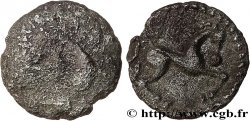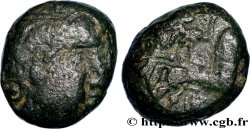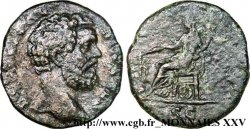bga_692532 - GALLIA - LEMOVICES (Regione di Limoges) Obole au cheval ailé
500.00 €
Quantità
Aggiungi al carrello

Tipo : Obole au cheval ailé
Data: c. 60-50 AC.
Nome della officina / città: Limoges (87)
Metallo : argento
Diametro : 9,5 mm
Asse di coniazione : 9 h.
Peso : 0,41 g.
Grado di rarità : R3
Commenti sullo stato di conservazione:
Monnaie bien centrée, avec de jolis détails au droit comme au revers. Belle patine sombre
Diritto
Titolatura diritto : ANÉPIGRAPHE.
Descrittivo diritto : Tête à gauche.
Rovescio
Titolatura rovescio : ANÉPIGRAPHE.
Descrittivo rovescio : Cheval ailé à droite avec un élément dessous.
Commento
Cette petite obole s’insère dans la série 1286 pour “les fractions en argent des peuples de l’ouest”.
Avec un avers inhabituel et un cheval ailé (?) à droite, cette obole ne correspond exactement à aucune des monnaies du Nouvel Atlas et elle ne semble pas recensée dans le remarquable article en ligne de la société numismatique du Limousin sur “les fractions en argent du “centre-ouest””.
This small obol is included in the 1286 series for “the silver fractions of the peoples of the west”. With an unusual obverse and a winged horse (?) on the right, this obol does not correspond exactly to any of the coins of the New Atlas and it does not seem to be listed in the remarkable online article of the Limousin numismatic society on “silver fractions from the “central-west”
Avec un avers inhabituel et un cheval ailé (?) à droite, cette obole ne correspond exactement à aucune des monnaies du Nouvel Atlas et elle ne semble pas recensée dans le remarquable article en ligne de la société numismatique du Limousin sur “les fractions en argent du “centre-ouest””.
This small obol is included in the 1286 series for “the silver fractions of the peoples of the west”. With an unusual obverse and a winged horse (?) on the right, this obol does not correspond exactly to any of the coins of the New Atlas and it does not seem to be listed in the remarkable online article of the Limousin numismatic society on “silver fractions from the “central-west”








 Segnalare un errore
Segnalare un errore Stampate la pagina
Stampate la pagina Condividi mia selezione
Condividi mia selezione Fai una domanda
Fai una domanda Consegnare / vendere
Consegnare / vendere
 Descrittivo
Descrittivo












